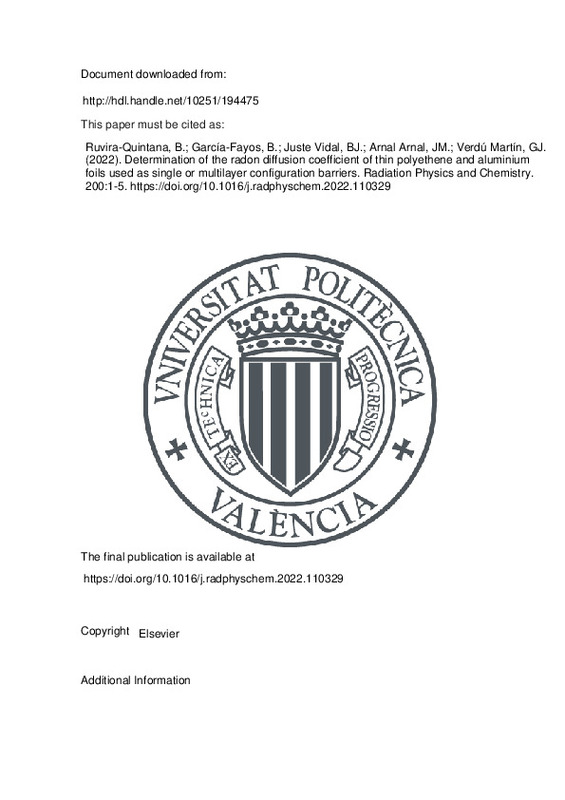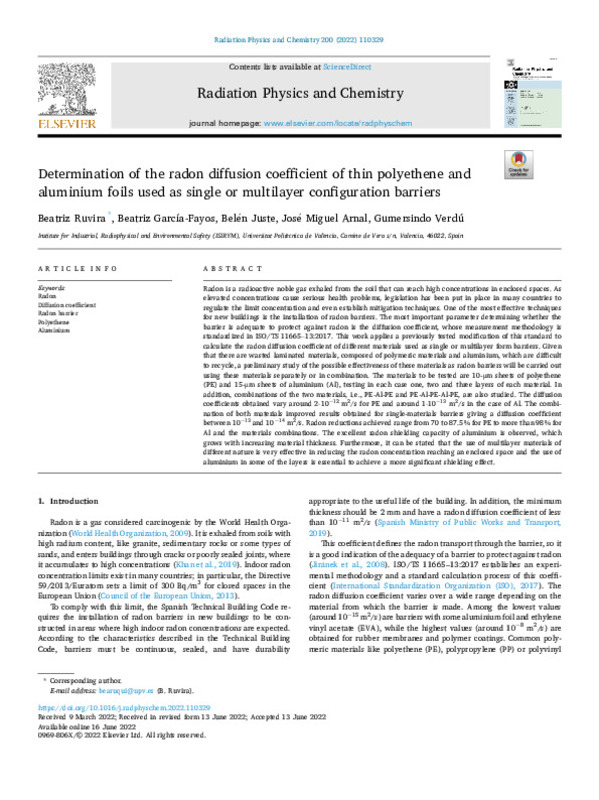JavaScript is disabled for your browser. Some features of this site may not work without it.
Buscar en RiuNet
Listar
Mi cuenta
Estadísticas
Ayuda RiuNet
Admin. UPV
Determination of the radon diffusion coefficient of thin polyethene and aluminium foils used as single or multilayer configuration barriers
Mostrar el registro sencillo del ítem
Ficheros en el ítem
| dc.contributor.author | Ruvira-Quintana, Beatriz
|
es_ES |
| dc.contributor.author | García-Fayos, Beatriz
|
es_ES |
| dc.contributor.author | Juste Vidal, Belen Jeanine
|
es_ES |
| dc.contributor.author | Arnal Arnal, José Miguel
|
es_ES |
| dc.contributor.author | Verdú Martín, Gumersindo Jesús
|
es_ES |
| dc.date.accessioned | 2023-06-21T18:02:15Z | |
| dc.date.available | 2023-06-21T18:02:15Z | |
| dc.date.issued | 2022-11 | es_ES |
| dc.identifier.issn | 0969-806X | es_ES |
| dc.identifier.uri | http://hdl.handle.net/10251/194475 | |
| dc.description.abstract | [EN] Radon is a radioactive noble gas exhaled from the soil that can reach high concentrations in enclosed spaces. As elevated concentrations cause serious health problems, legislation has been put in place in many countries to regulate the limit concentration and even establish mitigation techniques. One of the most effective techniques for new buildings is the installation of radon barriers. The most important parameter determining whether the barrier is adequate to protect against radon is the diffusion coefficient, whose measurement methodology is standardized in ISO/TS 11665¿13:2017. This work applies a previously tested modification of this standard to calculate the radon diffusion coefficient of different materials used as single or multilayer form barriers. Given that there are wasted laminated materials, composed of polymeric materials and aluminium, which are difficult to recycle, a preliminary study of the possible effectiveness of these materials as radon barriers will be carried out using these materials separately or in combination. The materials to be tested are 10-¿m sheets of polyethene (PE) and 15-¿m sheets of aluminium (Al), testing in each case one, two and three layers of each material. In addition, combinations of the two materials, i.e., PE-Al-PE and PE-Al-PE-Al-PE, are also studied. The diffusion coefficients obtained vary around 2¿10-12 m2/s for PE and around 1¿10-13 m2/s in the case of Al. The combination of both materials improved results obtained for single-materials barriers giving a diffusion coefficient between 10-13 and 10-14 m2/s. Radon reductions achieved range from 70 to 87.5% for PE to more than 98% for Al and the materials combinations. The excellent radon shielding capacity of aluminium is observed, which grows with increasing material thickness. Furthermore, it can be stated that the use of multilayer materials of different nature is very effective in reducing the radon concentration reaching an enclosed space and the use of aluminium in some of the layers is essential to achieve a more significant shielding effect. | es_ES |
| dc.description.sponsorship | This work is financed by the Spanish Nuclear Safety Council under the project 'Caracterización, exhalación y remediación de Radón en materiales de construcción (EXRADON). The authors would like to thank GDES for their collaboration during the research. | es_ES |
| dc.language | Inglés | es_ES |
| dc.publisher | Elsevier | es_ES |
| dc.relation.ispartof | Radiation Physics and Chemistry | es_ES |
| dc.rights | Reconocimiento - No comercial - Sin obra derivada (by-nc-nd) | es_ES |
| dc.subject | Radon | es_ES |
| dc.subject | Diffusion coefficient | es_ES |
| dc.subject | Radon barrier | es_ES |
| dc.subject | Polyethene | es_ES |
| dc.subject | Aluminium | es_ES |
| dc.subject.classification | INGENIERIA QUIMICA | es_ES |
| dc.subject.classification | INGENIERIA NUCLEAR | es_ES |
| dc.title | Determination of the radon diffusion coefficient of thin polyethene and aluminium foils used as single or multilayer configuration barriers | es_ES |
| dc.type | Artículo | es_ES |
| dc.identifier.doi | 10.1016/j.radphyschem.2022.110329 | es_ES |
| dc.relation.projectID | info:eu-repo/grantAgreement/CSN//SUB-33%2F2021//CARACTERIZACIÓN, EXHALACIÓN Y REMEDIACIÓN DE RADÓN EN MATERIALES DE CONSTRUCCIÓN / | es_ES |
| dc.rights.accessRights | Abierto | es_ES |
| dc.contributor.affiliation | Universitat Politècnica de València. Escuela Técnica Superior de Ingenieros Industriales - Escola Tècnica Superior d'Enginyers Industrials | es_ES |
| dc.description.bibliographicCitation | Ruvira-Quintana, B.; García-Fayos, B.; Juste Vidal, BJ.; Arnal Arnal, JM.; Verdú Martín, GJ. (2022). Determination of the radon diffusion coefficient of thin polyethene and aluminium foils used as single or multilayer configuration barriers. Radiation Physics and Chemistry. 200:1-5. https://doi.org/10.1016/j.radphyschem.2022.110329 | es_ES |
| dc.description.accrualMethod | S | es_ES |
| dc.relation.publisherversion | https://doi.org/10.1016/j.radphyschem.2022.110329 | es_ES |
| dc.description.upvformatpinicio | 1 | es_ES |
| dc.description.upvformatpfin | 5 | es_ES |
| dc.type.version | info:eu-repo/semantics/publishedVersion | es_ES |
| dc.description.volume | 200 | es_ES |
| dc.relation.pasarela | S\478589 | es_ES |
| dc.contributor.funder | CONSEJO DE SEGURIDAD NUCLEAR | es_ES |









